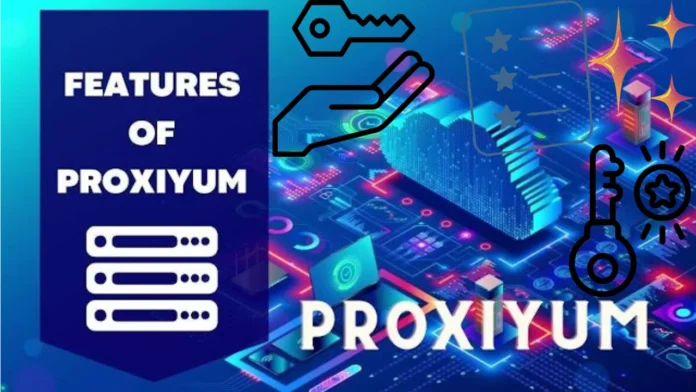The Proxiyum API is a robust, feature-rich application programming interface designed to simplify and enhance the development process for a wide array of digital solutions. From powering modern web applications to enabling complex IoT systems, the Proxiyum API provides developers with the tools necessary to build, scale, and secure their applications efficiently.
1.2 Importance in Modern Development
In today’s fast-paced technological landscape, APIs like Proxiyum are indispensable. They bridge the gap between different software components, allowing them to communicate seamlessly. This is critical for building modular, scalable applications that can adapt to changing business needs. Proxiyum’s API stands out for its ability to streamline development processes, reduce time to market, and improve the overall quality of applications.
1.3 Target Audience
This article is tailored for developers, technical architects, and IT managers who are exploring APIs for their projects. Whether you’re a seasoned developer looking for new tools to enhance your workflow or a beginner aiming to understand how APIs can improve your projects, this guide will provide you with comprehensive insights into the Proxiyum API.
2. Technical Specifications
2.1 API Architecture
The Proxiyum API is built on a RESTful architecture, making it stateless, scalable, and easy to use. REST (Representational State Transfer) is an architectural style that uses standard HTTP methods, enabling developers to interact with web services in a straightforward manner.
2.2 Supported Protocols
Proxiyum supports multiple protocols, including HTTP, HTTPS, and WebSockets. This flexibility allows developers to choose the protocol that best suits their application’s needs, whether it’s for secure data transmission or real-time communication.
2.3 Authentication Mechanisms
Security is a top priority with the Proxiyum API. It offers several authentication methods, including API keys, OAuth 2.0, and JWT (JSON Web Tokens). These mechanisms ensure that only authorized users can access the API, protecting your data and resources.
2.4 Rate Limiting and Throttling
To maintain optimal performance and prevent abuse, Proxiyum implements rate limiting and throttling. These features allow developers to control the number of API requests that can be made within a specific time frame, ensuring fair usage across all clients.
2.5 Data Formats Supported
Proxiyum API supports a variety of data formats, including JSON, XML, and YAML. This versatility allows developers to work with the data format that best suits their application’s requirements, making integration smoother and more efficient.
2.6 API Versioning
To accommodate ongoing updates and improvements, Proxiyum uses API versioning. This ensures backward compatibility and allows developers to migrate to new versions at their own pace, minimizing disruptions to their existing applications.
3. Applications
3.1 Use Cases in Web Development
The Proxiyum API is extensively used in web development to build responsive and dynamic web applications. Its flexibility allows for the integration of various third-party services, enhancing the functionality of web applications and providing users with a seamless experience.
3.2 Mobile App Integration
Proxiyum’s lightweight and efficient design make it ideal for mobile app integration. Whether you’re developing for iOS or Android, the API provides the necessary endpoints to interact with backend services, enabling real-time data synchronization and push notifications.
3.3 IoT and Embedded Systems
The rise of IoT (Internet of Things) has led to the need for APIs that can handle the unique requirements of embedded systems. Proxiyum is designed to work efficiently with IoT devices, allowing for the seamless exchange of data between sensors, devices, and cloud services.
3.4 Enterprise Solutions
For large-scale enterprise applications, Proxiyum provides the scalability and security needed to support mission-critical operations. Its robust architecture ensures that enterprise solutions can handle large volumes of data and concurrent requests without compromising performance.
3.5 Cloud Services and Microservices
As cloud computing and microservices architecture continue to dominate the tech landscape, the Proxiyum API offers tools to develop and deploy scalable cloud-based applications. Its compatibility with various cloud platforms makes it a valuable asset for developers working in these environments.
4. Benefits
4.1 Enhanced Developer Productivity
Proxiyum’s intuitive design and comprehensive documentation significantly enhance developer productivity. By providing easy-to-use tools and clear guidelines, developers can focus on building features rather than wrestling with the API’s complexities.
4.2 Scalability and Flexibility
One of the key benefits of Proxiyum is its scalability. Whether you’re working on a small project or a large enterprise solution, the API can scale to meet your needs. Its flexible architecture allows for easy adjustments as your project grows.
4.3 Cost Efficiency
Proxiyum is designed with cost efficiency in mind. By reducing the time and resources required for development, it helps businesses minimize expenses. Additionally, its pricing model is competitive, making it accessible for projects of all sizes.
4.4 Security Features
Security is a cornerstone of the Proxiyum API. It includes robust security features such as data encryption, secure authentication methods, and regular security audits, ensuring that your applications are protected against potential threats.
4.5 Speed and Performance
Proxiyum is optimized for speed and performance. Its lightweight design ensures fast response times, even under heavy loads. This makes it ideal for applications that require real-time data processing and high availability.
5. Challenges and Limitations
5.1 Learning Curve
Despite its many advantages, the Proxiyum API has a steep learning curve for beginners. Developers need to familiarize themselves with its various features and best practices to fully leverage its capabilities.
5.2 Compatibility Issues
While Proxiyum supports multiple platforms, compatibility issues can arise, particularly when integrating with legacy systems. Developers may need to invest time in troubleshooting and resolving these issues to ensure smooth operation.
5.3 API Downtime and Reliability
Like any online service, Proxiyum may experience downtime or reliability issues. While the API is generally stable, developers should be prepared for occasional service disruptions and implement strategies to mitigate their impact.
5.4 Security Concerns
Although Proxiyum is designed with security in mind, no API is completely immune to threats. Developers must remain vigilant and follow best practices for securing their applications to minimize the risk of data breaches.
5.5 Cost Implications
While Proxiyum offers a cost-efficient solution, the costs can add up, especially for large-scale projects or when using premium features. Developers should carefully assess their budget and choose the pricing plan that best suits their needs.
6. Latest Innovations
6.1 Recent Updates to Proxiyum API
Proxiyum is constantly evolving, with regular updates that introduce new features and improvements. These updates enhance the API’s functionality, making it more powerful and easier to use for developers.
6.2 Integration with Emerging Technologies
As new technologies emerge, Proxiyum continues to integrate with them, ensuring that developers have access to the latest tools and resources. This includes support for blockchain, AI, and machine learning, among others.
6.3 New Tools and SDKs
Proxiyum has introduced several new tools and SDKs (Software Development Kits) that simplify the development process. These tools provide pre-built functionalities, reducing the amount of code developers need to write and speeding up the development process.
6.4 Community Contributions and Open Source Projects
The Proxiyum community is active and vibrant, contributing to open-source projects and sharing resources that benefit all users. This collaborative environment fosters innovation and helps developers overcome challenges more quickly.
7. Future Prospects
7.1 Predicted Trends in API Development
The API landscape is constantly changing, and Proxiyum is poised to adapt to these shifts. Predicted trends include increased focus on security, the rise of serverless architectures, and the continued growth of microservices.
7.2 Proxiyum API’s Future Roadmap
Proxiyum has an ambitious roadmap that includes plans to introduce more advanced features, improve scalability, and enhance user experience. Developers can look forward to a continuously improving API that meets the evolving demands of the industry.
7.3 Evolving Standards and Best Practices
As industry standards and best practices evolve, Proxiyum is committed to staying ahead of the curve. This includes adopting new security protocols, improving data handling practices, and ensuring compliance with regulations.
7.4 Potential Market Impact
With its robust feature set and forward-thinking development strategy, Proxiyum is well-positioned to make a significant impact on the market. Its ability to adapt to new trends and technologies ensures that it will remain a valuable tool for developers in the years to come.
8. Comparative Analysis
8.1 Proxiyum API vs. Competitors
When compared to its competitors, Proxiyum stands out for its ease of use, comprehensive documentation, and strong community support. These factors make it a preferred choice for many developers, particularly those working on complex projects.
8.2 Advantages Over Traditional APIs
Proxiyum offers several advantages over traditional APIs, including better scalability, more robust security features, and a more flexible architecture. These benefits make it an ideal solution for modern development needs.
8.3 Comparison with Similar API Solutions
When compared to similar API solutions, Proxiyum consistently ranks higher in terms of performance, reliability, and ease of use. Its extensive feature set and active community support further enhance its appeal.
8.4 Case Studies Highlighting Proxiyum’s Superiority
Numerous case studies highlight the superiority of Proxiyum in real-world applications. These examples demonstrate how the API has helped businesses improve their operations, reduce costs, and deliver better user experiences.
9. User Guides and Tutorials
9.1 Getting Started with Proxiyum API
Getting started with Proxiyum is straightforward, thanks to its comprehensive documentation and user-friendly interface. Developers can quickly set up the API and begin integrating it into their projects with minimal effort.
9.2 Step-by-Step Integration Guide
The step-by-step integration guide walks developers through the process of integrating Proxiyum into their applications. This includes setting up the API, configuring authentication, and testing the integration to ensure everything is working correctly.
9.3 Troubleshooting Common Issues
Despite its ease of use, developers may encounter issues when working with Proxiyum. The troubleshooting guide provides solutions to common problems, helping developers resolve issues quickly and efficiently.
9.4 Best Practices for Optimization
To get the most out of Proxiyum, developers should follow best practices for optimization. This includes optimizing API calls, managing resources effectively, and ensuring that their applications are scalable and secure.
9.5 Advanced Usage Scenarios
For developers looking to push the limits of Proxiyum, advanced usage scenarios offer guidance on how to leverage the API’s full potential. This includes integrating Proxiyum with other services, implementing custom solutions, and optimizing performance for large-scale applications.
10. Conclusion
10.1 Recap of Key Points
The Proxiyum API is a powerful tool that offers developers a wide range of features and benefits. From its robust security measures to its flexibility and scalability, Proxiyum is well-suited to meet the needs of modern developers.
10.2 Future Implications for Developers
As the API landscape continues to evolve, Proxiyum is positioned to remain a leading solution for developers. Its commitment to innovation and user experience ensures that it will continue to meet the demands of the industry.
10.3 Call to Action for Further Learning
Developers interested in learning more about Proxiyum should explore the available resources, including documentation, tutorials, and community forums. By staying informed and engaged, developers can maximize the potential of Proxiyum and build better applications.

